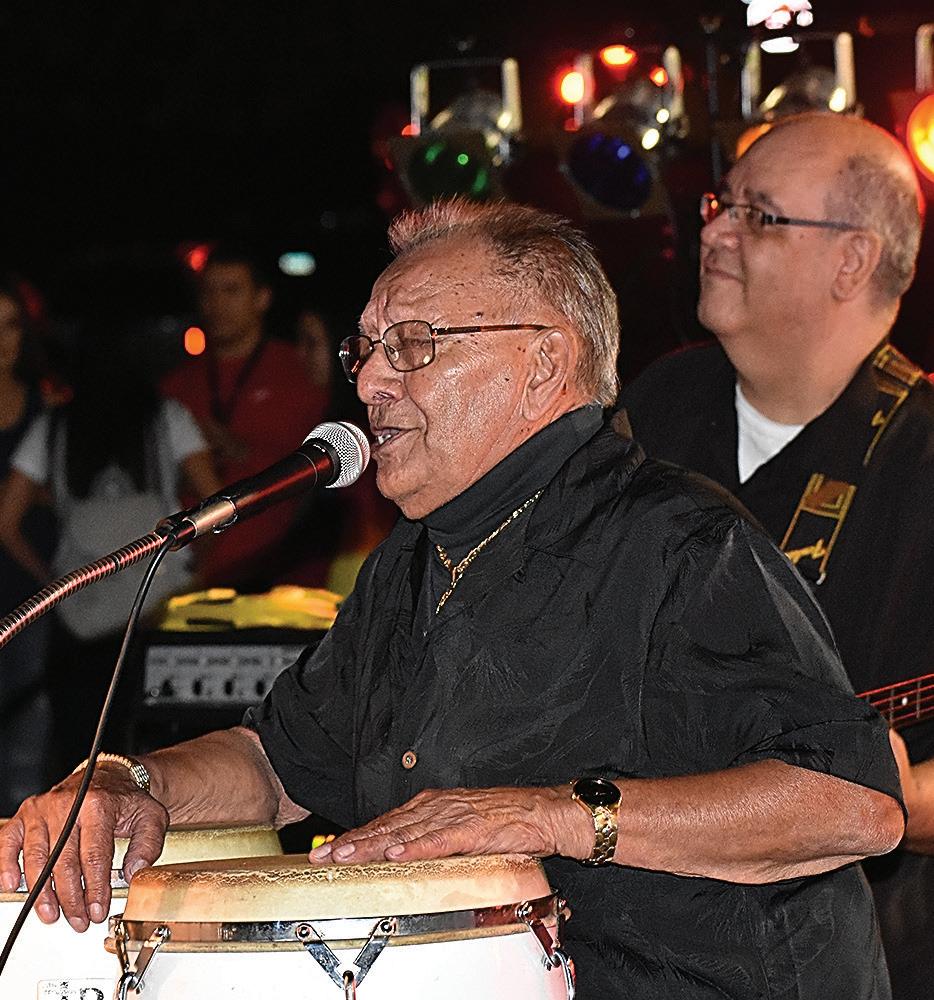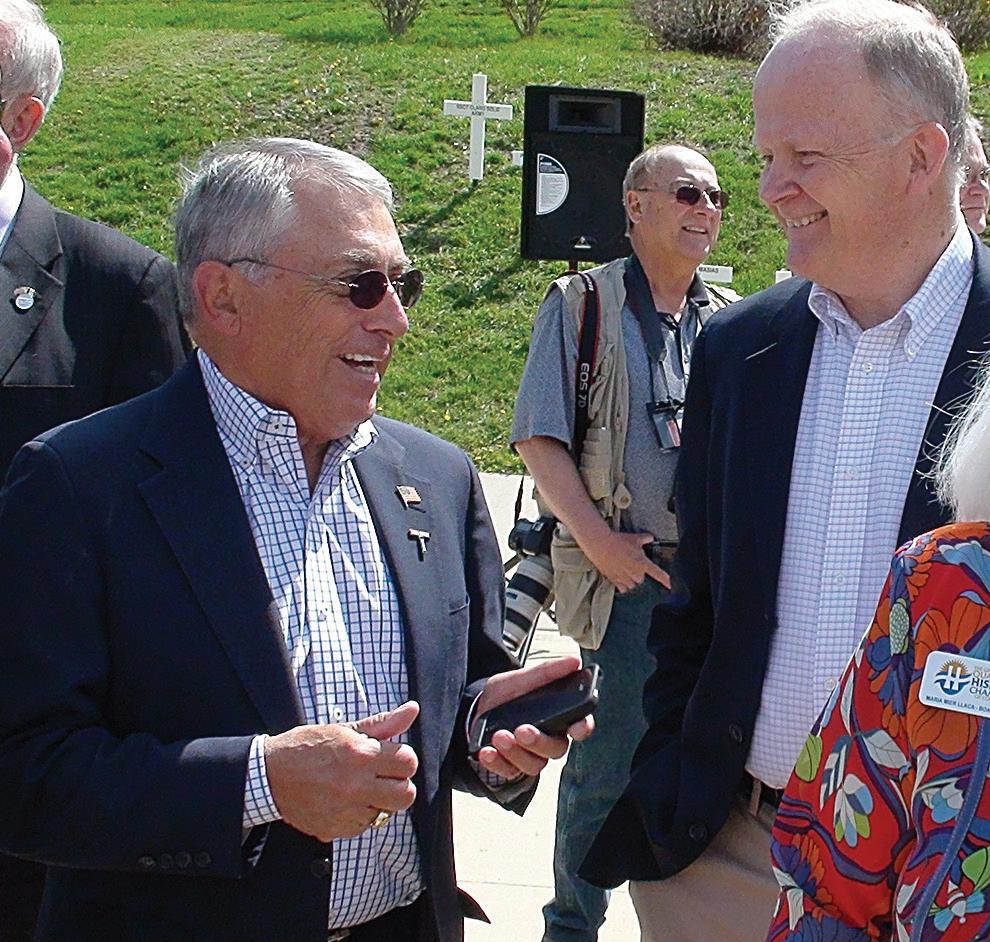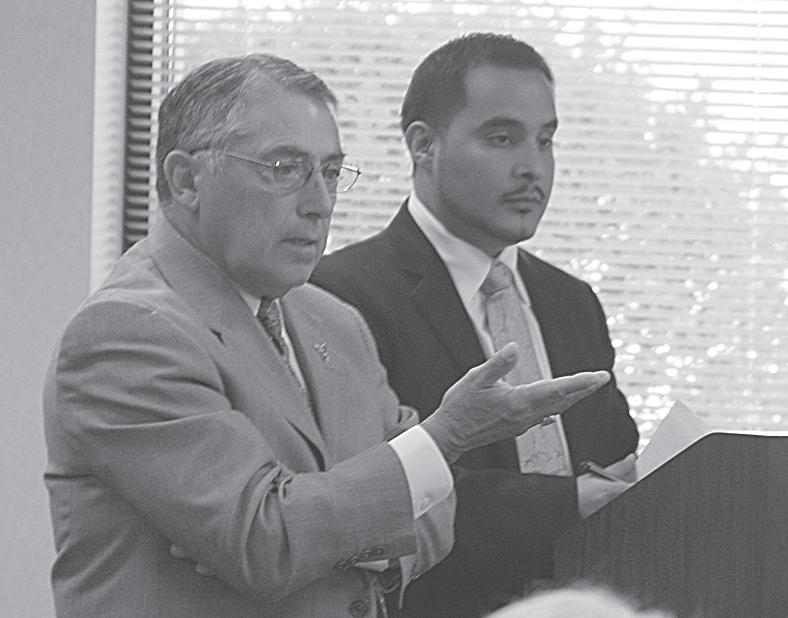
16 minute read
Judge Norma Kauzlarich to run for the Fourteenth Judicial Court in Illinois
AROUND THE QC
On the morning of February 9 Mr. Richard Esparza joined our ancestors. Mr. Esparza was one of the original members of the Band Los Mocambos 60 years ago. He is pictured here at Los Mocambos’ 55th anniversary at Mercado on Fifth in 2017. Our thoughts and prayers are with the Esparza family.
Advertisement
En la mañana del 9 de febrero el Sr. Richard Esparza se unió a nuestros antepasados. El Sr. Esparza fue uno de los integrantes originales de la Banda Los Mocambos hace 60 años. El aparece en esta foto en el 55 aniversario de Los Mocambos en Mercado on Fifth en 2017. Nuestros pensamientos y oraciones están con la familia Esparza.
Judge Norma Kauzlarich to run for the Fourteenth Judicial Court in Illinois.
Associate Judge Norma Kauzlarich announced her candidacy for the Fourteenth Judicial Circuit last Thursday February 3rd, 2022 at the American Legion Hall Post 829 in East Moline, IL. “Judge Kauzlarich is running for the Fourteenth Judicial Circuit so that she can continue to contribute to the high standards, integrity and decorum of the court while bringing her unique and alternate perspective to court proceedings. She has high expectations of herself and a strong work ethic and wishes to continue to keep those attributes in the courtroom.” Said the press release. Judge Kauzlarich brings over 25 years of law experience and 7 years as a judge. Between college and law school, she worked at a Chicago public relations firm working with the Superbowl Bears, the Chicago Bulls and various other national and international companies providing support to the firm and the media in English and Spanish. She was in private law practice from 1995 to 2001 concentrating in family law, immigration and criminal matters. From 2001 to 2011, she served as an Assistant State’s Attorney initially assigned to civil & traffic matters, then to the sex assault and abuse matters eventually leading her to be the “drug prosecutor” from 2004 - 2011. In 2011, Judge Kauzlarich was selected as the first female “First Assistant State’s Attorney” (akin to Deputy Chief State’s Attorney). She was appointed as an Associate Circuit Judge in October 2014. When she was sworn in as an Associate Judge, she was the sixth woman to ever become a judge in the Fourteenth Judicial Circuit, the first Latina and second person of color to be appointed to the bench. Until December, 2021, she was assigned to criminal felony court and currently, she is assigned to Mercer County, Whiteside County and Rock Island County juvenile court.
About Judge Norma Kauzlarich:
Born in Moline, Illinois; moved to Mexico; returned in January, 1969 and entered kindergarten as a non-English speaking student. She is a graduate of Moline Sr. High School, Northern Illinois University and the accelerated program at the University of Iowa Law School where she graduated with her youngest sister.
Foto por Tar Macias / Hola America


Judge Norma Kauzlarich Photo from Hola America Archives
The sights and sounds of the Mexican-American Border come to life in Border Cantos | Sonic Border exhibition at the Figge
For most Quad Citians, the Mexican-American border region is shown to us through the lens of the media. The first-hand experience of the migrants seeking a better life often go unknown, unacknowledged, or unconsidered. The Figge Art Museum is presenting an exhibition of work inspired by the Mexican-American border region that humanizes the border and the depictions in our minds. Border Cantos | Sonic Border brings together the sights and sounds of the border through a transformative and multi-sensory experience created by photographer Richard Misrach and composer/artist Guillermo Galindo invites us to bridge boundaries and initiate important conversations. Misrach’s large-scale photographs beautifully capture the various types of landscapes, textures, and experiences found across the almost 2,000-mile dividing line that brings us face-to-face with the reality of the region. Galindo’s Sonic Borders installation is an original score for eight instruments, created out of discarded objects found and collected at the border. The composition embraces the pre-Columbian belief that there was an intimate connection between an instrument and the material from which it was made, with no separation between spiritual and physical worlds. Based on the Mesoamerican “Venus calendar,” Sonic Borders plays for a total of 260 minutes and will play in the gallery space for all visitors to experience. “It is so important for the Quad Cities to have an opportunity to experience this exhibition,” said Figge Executive Director and CEO Michelle Hargrave. “Art surrounding the Mexican-American border is more relevant than ever and this body of work compels us to put ourselves in the shoes of these migrants so we can attempt to envision their collective journeys in the hopes of more understanding and compassion for their plight.” Misrach and Galindo began collaborating in 2011 when they discovered they were both creating bodies of work inspired by the border. The two artists came together to show moments of disruption on the land and the difficult work of policing the boundary. When experienced as a whole, the images, instruments, and emanating sounds of this exhibition create an immersive space in which to look, listen, and learn about the complicated issues surrounding the Mexican-American border. While the artists do not seek to provide solutions to these issues, they do provide insight into a place where most people have never ventured, creating a poignant connection that draws on our humanity. “This exhibition represents an extraordinary collaboration, and we are pleased to be able to share it with the Quad Cities community, said Director of Collections and Exhibitions Andrew Wallace. “We were lucky to include several key works by Richard Misrach in our recent Magnetic West exhibition, and Border Cantos will highlight the importance of the photographer’s career dedicated to surveying the American West. Guillermo Galindo’s sonic sculptures enhance the experience by humanizing the geopolitical boundary so frequently in the news.” Visitors will be invited to share their stories of movement or migration on a map located in the Figge’s Learn to Look Gallery adjacent the exhibition; public programming will provide opportunities to meet the artists and discuss their work in dialogue with the community. The Figge’s Director of Education, Melissa Mohr, is looking forward to several interactive public programs accompanying the exhibition. “We want to provide a visitor experience that emphasizes what we have in common,” Mohr says. “We will be collecting messages of kindness from community members and printing them on foam bricks that will be used to build wall structure. Community members will be invited to take out the bricks, read them, and keep them as a connection to the exhibition and to the museum – a connection that is hopefully personally meaningful. It is a way for the community to work together to dismantle a wall that divides us and focus on the messages that unite us.” Organized by Crystal Bridges Museum of American Art, Border Cantos | Sonic Border will be on view through June 5, 2022, in the Figge’s second-floor Katz Gallery.
Companion Programs:
Opening Program: Border Cantos | Sonic Border with artist Guillermo Galindo Thursday, February 17, 6:30 p.m. Join artist Guillermo Galindo for a performance and talk in conjunction with the opening of Border Cantos | Sonic Border. Space is limited and registration is required.
Virtual Artist Talk: Border Cantos | Sonic Border with artist Richard Misrach Thursday, March 25 Artist Richard Misrach, one of the most influential photographers of his generation, will give a virtual talk about his work that is featured in Border Cantos | Sonic Borders. Registrants will receive an email two hours prior to the start of the event with a link to the Zoom event.
Wall, Los Indios, Texas, 2015, printed 2017. Artist: Richard Misrach, born 1949 Photo: Courtesy the Artist

Free Family Day – Live on the Figge Plaza
Sunday, May 1, Noon-5 p.m. Join us for a day of family fun related to Border Cantos | Sonic Borders on the Figge’s Bechtel Plaza.
By Marc Wilson
Bob Ontiveros would come by my office on 47th Avenue in Moline once or twice a month and we’d go to lunch. He knew I had a back door that (against rules) I kept open in the day time, and he’d quietly slip inside. If I wasn’t in my office, he would go next door into the break room, help himself to a cup of coffee, and wait in my office. When I came back to my office, I’d find him sitting across from my desk. He’d lift the coffee cup up and say, “You have the best coffee – FREE!” One day, many years ago, he asked me where I wanted to go for lunch. I told him I’d like to go to one of my favorite Mexican food restaurants, El Mexicano. “I can’t get any of my other friends or wife to go there with me. Will you go with me?” A big smile lit up his face. “Let’s go!” he said. We jumped in his car and turned onto 16th Street. “This place is hard to find,” I told him. “We may need to use your GPS.” Bob glanced at me with a smile. “I know the way.” We got to the top of the hill and started down toward the Floreciente neighborhood. “I always get lost around here,” I said. “Maybe use the GPS?” “I know the way,” Bob repeated, again with a smile and a side glance at me. He turned on 12th Avenue until we reached Stephens Park. Then he turned right on 7th Street. Bob quickly found Railroad Avenue, and
Bob Ontiveros and long time friend Marc Wilson at Hero Street Park on May 6, 2014. Photo by Erika Macias / Hola America
pulled in front of the restaurant, and parked his car. We walked into the restaurant/grocery store. I could have been with Barack Obama for all the attention we got. Bob waved at everyone, and everyone waved and/or smiled. He talked to everyone. Bob was a legend. After we ate, Bob said, “Let’s take a little walk.” We went a couple of blocks before Bob stopped us in front of an old two-story wooden house. Maybe 1,200 square feet. “See that house?” I nodded. “That’s where I grew up -- 12 kids, two parents and my grandmother. That’s where I got my start.” He came a long way, but he never forgot his roots. He knew the way.

About Bob
Bob Ontiveros’ maternal grandparents, Cirilo and Delores Rocha fled to the United States in 1918 in the midst of horrific conditions during the Mexican Revolution, settling – after brief stops at Cook’s Point in Iowa -- in the west end, now Floreciente neighborhood, in Moline, Illinois. Cirilo’s and Delores’ daughter, Josephine, married John Ontiveros, whose parents had fled from Guadalajara, Mexico during the Mexican Revolution, arriving in the United States in 1918. Bob was their second child, born in 1938 while World War II was beginning and when the national unemployment rate was 19 percent – and probably double that in his neighborhood in the west end of Moline Economic conditions improved during World War II, but, Bob said: “As a child, if you wanted new shoes you had to find the money. You had to work hard for it. You should have seen me as a kid walking down the block, asking people if I could cut their grass or clean their garage.” His first job, at about age 8, was picking onions in the Pleasant Valley, Iowa area. “My older brother and I walked 12 blocks to the bridge over the Mississippi River where a truck picked up the kids – almost all Mexican-Americans – who would work the onion fields. “I was always small, and not much bigger than the bushel basket I dropped the onions in,” he told Fourth Wall Films in an interview. He also worked as a child farm laborer picking tomatoes and strawberries. “As a kid, if you wanted something, you had to work for it,” he said. “Our parents didn’t have any money to spare.” Much of his earnings went to his grandmother, who managed the family’s finances. His father worked as a tool and die specialist at the roundhouse at the Rock Island Railroad yard in Silvis. He would be laid off frequently. “My dad told me ‘the Mexicans are the last ones hired and the first ones fired. Dad looked at layoffs as vacations, but the family suffered.” Bob loved to work. He worked as a busboy at the 15th floor restaurant atop the LeClaire Hotel in downtown Moline. “I worked hard, and I loved to work,” Bob once told me. “I liked the idea of making money and getting ahead.” Get ahead he did. After graduating from Moline High, Bob worked his way through Moline Community College, now Blackhawk Community College. (He and his wife, Blenda, gave the college $1 million last year.) While in college, he met Blenda Crummer, a tall blonde girl from Freeport, Illinois. “My family and friends wondered what I was doing getting mixed up with a short Mexican guy, but they all learned to love him,” she once told me. “My best decision ever!” They were married 61 years. In 1974, Bob started selling packaging materials out of the family station wagon, and soon founded Bi-State Packaging. Through hard work and dogged determination – and great sales skills – Bob’s
Continues next page
Continues from previous page
company grew to the point of needing warehouses throughout the United States, Mexico and Puerto Rico. Bob started separate companies, R&O Specialties and Group O Direct. In 2007, the three companies were merged under the Group O brand, headquartered in Milan, Il. Today, under the leadership of Bob’s and Blenda’s son, Gregg, Group O is one of the largest Hispanicowned businesses in the United States. Major clients include AT&T, Bristol-Myers Squibb, Caterpillar, Frito-Lay, Kraft Foods, Microsoft, PepsiCo, and Staples. The U.S. Hispanic Chamber of Commerce ranks Group O as one of the top five Latino-owned businesses in the country. The company’s annual revenues are over $900 million. With over 1,000 employees, Group O is one of the largest employers in the Quad Cities (behind Deer and Co. and Alcoa/Arconic.) Bob loved to sell things – anything, and he was great at it. His son Chris tells this story: “Dad likes to say, ‘Do me a favor, will you?’ “And of course you answer, ‘Sure, what?” “Sell something!” And he’d smile the famous Bob Ontiveros smile. “He never told us what to sell,” Chris added. “He wanted us to find out what the customer wanted, and sell ‘em that. He was always about making the customers happy – and selling them something.” Bob never forgot his roots, especially the Floreciente neighborhood, especially after he retired as CEO of Group O and became chairman of the company in 1999. He financed and raised money for a neighborhood Community Health Center, the Moline Boys and Girls Club (including the Ontiveros Teen Center) and the Mercado on Fifth Street, which is run by his granddaughter, Maria. Bob was especially enthused about the Boys and Girls Club. “I want the kids from my old neighborhood to know how much opportunity there is in this country if you work hard and apply yourself,” Bob once told me. “The United States is truly the land of opportunity.” Bob also was instrumental in the late 1980 and early 1990s in helping raise some $30 million for the 12,000-seat arena in downtown Moline, originally known as the Mark of the Quad Cities, and now known as the TaxSlayer Center.) “The Mark is one of my father’s proudest accomplishments.”his son, Chris, told me. (To me, it’s not the “Mark” or the TaxSlayer Center. I call it the “Bob.”) Bob was the driving force behind the founding of the Greater Quad Cities Hispanic Chamber of Commerce. “I was fortunate to succeed, and I felt it was my duty to give back to the Latino community. That’s why I started the Hispanic Chamber of Commerce and why my wife and I are big on funding scholarships,” he said. “Education is the key to success.” He quietly supported almost all efforts, big and small, to enhance the lives of Quad City residents, especially Mexican-Americans. His Group O was the sponsor or co-sponsor on many programs and events in the Quad Cities. He and Group O were major backers of all fund-raising efforts connected with Hero Street U.S.A. and other Latino-based events. Bob has been a major supporter of Fourth Wall Films efforts to produce documentaries about Hero Street U.S.A. in Silvis. Hero Street is famous for having the most combat deaths of any single street in the United States – eight Mexican-American soldiers born to refugees of the Mexican Revolution. He helped pay for the English-to-Spanish language translation of my book, Hero Street U.S.A. Bob has met and befriended powerful politicians, company executives and major sports figures (golfers Jordan Speith and Jason Duffner help Bob with the Boys and Girls Club). Bob’s son, Gregg, is a regular participant at the AT&T Pebble Beach Pro-Am in California. Bob often attended the event, which Gregg once won as the amateur partner. “I loved meeting and eating with all the celebrities,” he said. As a successful businessman, entrepreneur and donor, he met and knew high-ranking politicians and leaders. He became a partner in a Chicago-area casino. But he always knew the way home. “I was very fortunate,” he said. “Maybe I succeeded in part because I have green eyes, brown hair and pretty light skin. But I know racism continues to be a problem. They say it’s going away – but it’s not. The immigrant struggle continues. “I took advantage of my opportunities, and now it’s time to give back,” he said after he retired. All through his life he remained a man with simple tastes. “Take a look in his closet and you’ll learn a lot about the man,” his son Chris told me. “He has four shirts, four pairs of pants and two pairs of shoes. Nothing else. He’s done so many wonderful things for so many people, but he never did much for himself. He always remembered where he came from.” He knew the way home.







